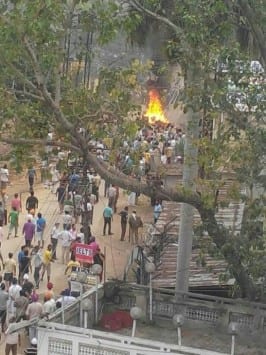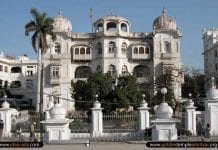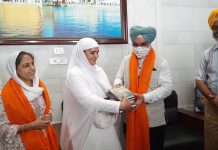


Saharanpur, India— Uttar Pradesh’s poor run with law and order shows no sign of abating. On Sunday, in a bid to keep a check on ‘mischievous elements’, the Uttar Pradesh administration deployed drone cameras in curfew-bound Saharanpur, a day after three people were killed and over a dozen critically injured in communal violence.
Police officials said the situation in Saharanpur city was under control but tense, although there was no major incident of violence since late Saturday night.
A curfew, clamped on Saturday, in six police station areas of Saharanpur remains partially in force.
As the situation has shown some improvement, curfew was relaxed today, from 10 am till 2 pm in the new city and from 3 pm to 7 pm in the old town areas. “This is being done to allow people to pick up their items of daily need from the markets,” District Magistrate Sandhya Tiwari told reporters. Schools, however, will remain shut till 30 July.
Tiwari also said security forces have been asked to maintain a tight vigil during the curfew relaxation hours and keep a close watch on trouble-mongers to prevent any untoward incident.
She said a lot of people contacted the authorities last night with rumours of more trouble, but “more than 96 percent of the incidents were not found to be true”.
On Saturday, violent clashes erupted between Sikhs and Muslims along Ambala Road over a land dispute near a Gurdwara. Both communities claim ownership of the land, and the violence reportedly erupted after the Gurdwara committee began construction at the site.
Anger quickly spread in the city, leading to arson. Groups of mostly young people fought pitched battles on the streets, using stones and bricks as weapons. The Kutubsher police station, which is 50m away from the Gurdwara, is now at the centre of the divide, reports The Indian Express, further adding that police barricades have now been put up outside their residential colonies preventing them from moving across.
Several vehicles were burnt in the frenzy, gun shots were fired and business establishments were targeted. With an injured man succumbing to injuries, the death toll in the clashes now stands at three, officials said.
The condition of over a dozen injured, mostly with gun shot wounds, is critical, officials said. They include a police constable and a Home Guard.
“Yesterday, some men came to this area with the police and started firing rubber bullets… They smashed the window panes of the mosques, torched cars and damaged shops. I don’t know who they are and why they came here. I just know that this Eid is not going to be the same,” a woman who declined to be identified told The Indian Express.
The same view was articulated by Gursharan Kaur from the Sikh community, who told the daily: “I do not know if it is politically motivated or not. But I saw that the maximum violence was being done by outsiders, not the locals. They came from Moradabad, Muzaffarnagar and Deoli and went on a rampage. I do not remember seeing any known Muslim face among the people who were torching vehicles and burning down shops. It seems that it was all pre-planned.”
Akhilesh Yadav has reportedly spoken to Punjab deputy chief minister Sukhbir Badal, assuring him that all possible assistance would be provided to those affected by the clashes. “Anybody in trouble can meet me,” he reportedly told Badal over a telephonic conversation.
More than 3,000 armed personnel from Paramilitary forces, including the Indo-Tibetan Border Police, Central Reserve Police Force and Rapid Action Force, have been deployed in the area after Akhilesh Yadav spoke to Union Home Minister Rajnath Singh. The maximum deployment has been done in areas where the population is a mix of Muslims, Sikhs and Hindus.
The Uttar Pradesh police arrested at least 38 people for the violence, with nine FIRs being registered. The government also said that they would book those guilty under the stringent National Security Act, underwhich obtaining immediate bail is difficult.
“All those who were active in Saturday’s riots will be booked under NSA,” ADG (law and order) Mukul Goel told The Times of India.
Meanwhile, Samajwadi Party leader Azam Khan alleged that the violence was the handiwork of the RSS, while the BJP leader Kalraj Mishra claimed Pakistan’s ISI was behind the flare-up, TOI reported. Local Congress leader Pappu Ali has been named in the FIR but is yet to be arrested.
But incidents of violence in Uttar Pradesh have risen sharply in recent months, with more trouble expected as bypolls to about a dozen Assembly seats come up later this year. As an earlier article on Firstpost had argued:
The state government’s culpability in not acting quickly or effectively when Muzaffarnagar burnt kicked off a resurgence of politics of identity just before election season. It also realigned caste alliances and loyalties — helped along with BJP’s own election strategy. And it’s now obvious that the seismic shifts revealed by the election results are still playing out.
There are bypolls to about a dozen Assembly seats in Uttar Pradesh scheduled for later this year. Mulayam Singh Yadav’s very own Mainpuri Lok Sabha constituency will go in for a bypoll too, the SP supremo having vacated this seat while retaining Azamgarh. The elections will come just as Akhilesh completes two years of his tenure as the country’s youngest chief minister, and at a time when the Samajwadi Party finds its support base deeply eroded.
In UP’s highly polarised polity, communal fervour is visibly thriving. It takes little now in Uttar Pradesh to turn a minor fracas into a communal faceoff.
While curfew in Saharanpur has been partially lifted, and the Centre has begun discussing the violence at a high-level meeting in New Delhi, what remains to be seen is how the BJP-led NDA government manages to pull up the Akhilesh Yadav government.




